Rick's b.log - entry 2024/03/30 |
| ||||||
mailto: blog -at- heyrick -dot- eu
You are not reading my b.log using HTTPS. You can switch to HTTPS by clicking here. The walnut treeThe walnut tree is by the back of the house. It wasn't supposed to be there, it was a seed that mom dropped and couldn't find that decided "yup, here's good".Problem is, it isn't growing straight.
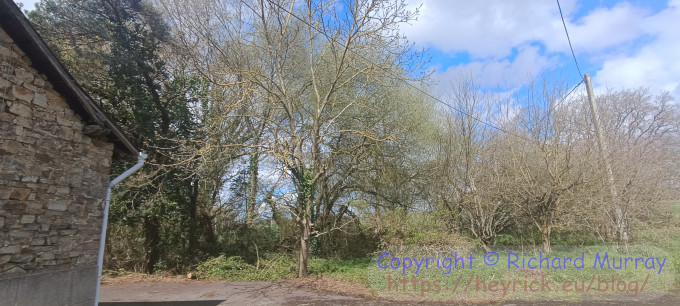 The walnut. I have already removed some of the lower limbs back towards the end of winter, because when the tree has leaves and nuts, it would hang so low I'd be driving through a bush of leaves. It wasn't until I cleared up around the tree that I got to see quite how out of line the tree was growing.
 That's not quite upright, is it? The problem is that if it should give up and fall over, it'll pretty definitely take out the phone line, and may well take out the electricity as well. It's just unfortunate placement, but then I guess a quarter century ago (when we would wrap a microfibre bag around this sapling in the winter) we didn't really conceive of how big it would become.
So I got out the big ladder, extended all three sections, and climbed to a height about halfway up the roof level (up to the 'Y' not far from the phone line) and started lopping some bits off.
I took off some lower limbs as well, to try to balance out the tree and not have too much pulling it in the direction that it is leaning.
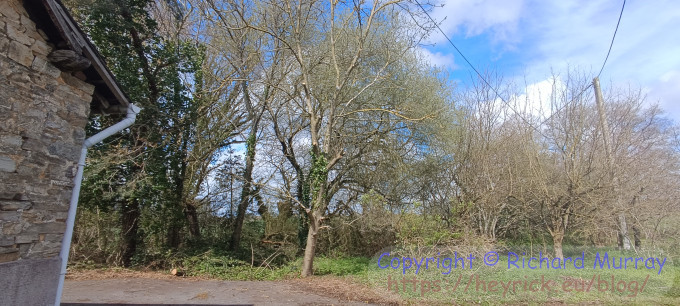 Trying to tidy the walnut. As I was doing that, I watched with some degree of amazement as a Beluga (or maybe BelugaXL?) flew over on its way to St. Nazaire. They fly low, this wasn't much higher than the planes coming into Rennes and they're 7000-12000 feet depending on weather (in feet because that's what FlightRadar24 tells me), but the most surprising thing was that you'd expect an aircraft of that size to make an unholy racket like the Dreamliners, but, then, maybe that's just Boeing? ☺
Looking at other sequencersIn order to get some ideas for SimpleSeq, I rummaged around to find some DOS MIDI packages to try. DOS rather than Linux as I could try them using DOSbox, and also because I wanted something that would primarily work with MIDI files, as modern DAWs are way too complicated.
QSEQThe first package I came across is QSEQ (Quick SEQuencer). The manual, written by a Frenchie, started out well with:You must not: sell, copy, nor give away the fully functional version of this program, except to your baby sister, provided she is less than three years old but I doubt if she will thank you for it,... especially if you just have one brother and a cat. The initial view is "Global view" and it looks like this: 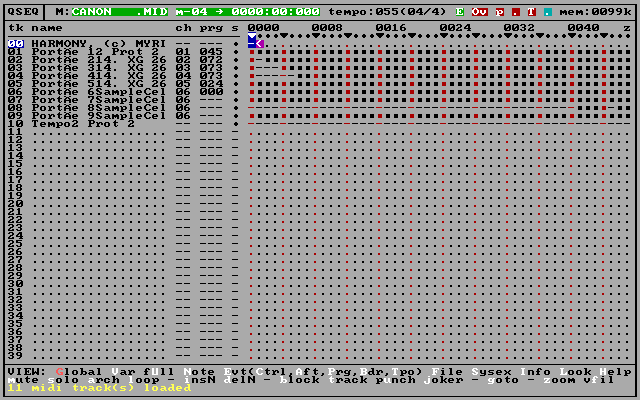 QSEQ Global View. If you faff around, you can find the notes/pianoroll. 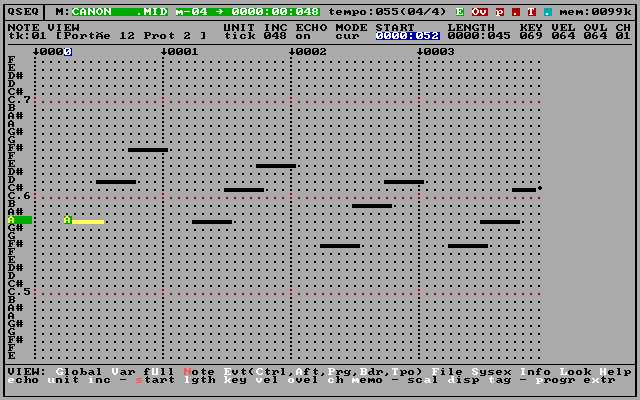 QSEQ Note View. I can imagine that QSEQ is a powerful program, but it would appear to have quite a learning curve. Takeaways from QSEQ? Not much. It's a more comprehensive package than my SimpleSeq, so there are some MIDI things to look at supporting in the future, like this: 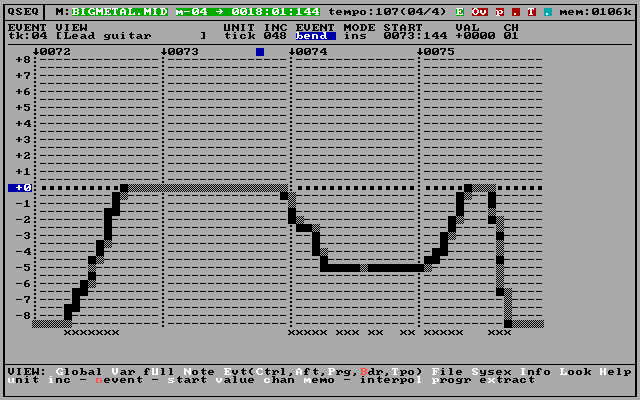 QSEQ Visualising Pitch Bends.
VoyetraThis starts up in a similar manner to QSEQ.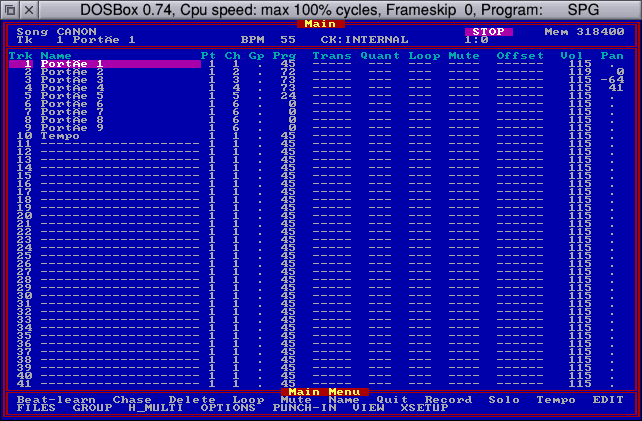 Voyetra Global View.
Oh, oops, I took a screenshot of the entire window and not just its contents. Anyway, this starts up in a manner similar to QSEQ, but I can see what it is doing more - it is listing the channels (and for some reason getting the names even more wrong) along with channel settings. 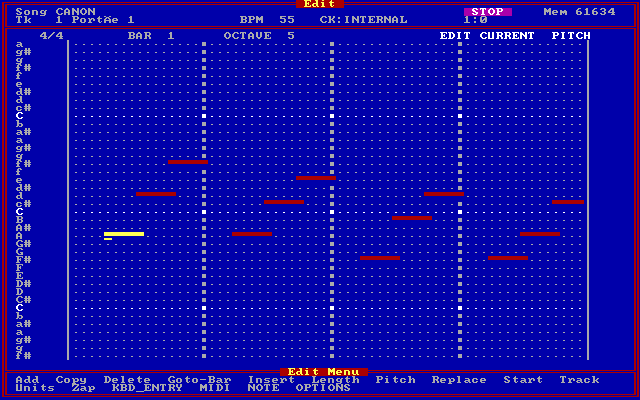 Voyetra Notes View. Takeaways? None. It seems to offer quite a number of transformations on the music, but try as I might I couldn't find any reference to Pitch Bend, other than something called "Pitch" that complained that it only applied to Aftertouch and didn't do anything else.
SoundclubThis one threw away the text mode interface to make it's own GUI. It isn't a full GUI as the windows don't appear to be repositionable, but as you can clearly see it's head and shoulders above things built around text.
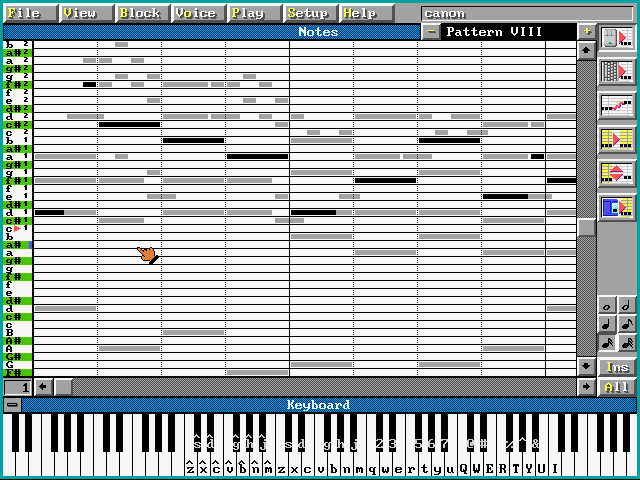 Soundclub's UI.
Soundclub could have perhaps benefitted from some sort of pop-up "tooltips" for the uninitiated (that didn't want to read all of the built-in help), but it's clear from the outset that this is aimed at making music rather than programming MIDI. With everything being pointy-clicky, I think it would be much less bother to get started with this than the others.
Now, here's the thing. Soundclub is not a MIDI sequencer. It's a music creation package that happens to talk MIDI. As well as various other common formats typical of its era such as .mod. Takeaways? Pointy-draggy note placement makes things easier. I ought to do something like that...
Cakewalk ProfessionalThis is an old version of Cakewalk, for Windows 3.1x. It's a little confusing at first, but pretty powerful. This has a lot of options, but then it's not by any means trying to be "simple".
 Cakewalk on Windows 3.11.
SimpleSeqBy comparison, this is mine.
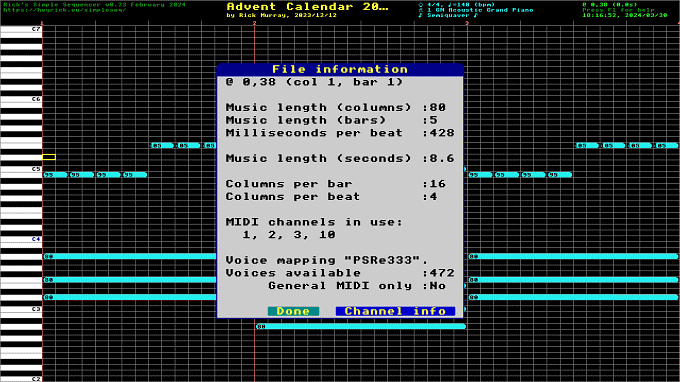 SimpleSeq with a dialogue open.
Like Soundclub, the primary view is that of the music, however it usually shows each channel separately.
Looking at it, even though my sequencer carries some limitations, I think it holds up well against similar-ish packages, and it is - in my obviously biased opinion - much easier to use as it puts the notes first and foremost. There are, of course, always things that can be done or added, but I think it's not a bad little program for creating music. On the other hand, Rhapsody4 supports typical musical notation, so you can easily repeat a section of music by notating a repeat around the intended bars. SimpleSeq is strictly linear, though it's easy to copy-paste previous music to have the same effect as a repeat.
 The following is played: 1, 2, 3, 2, 3, 4, 5. I was basically messing around today so I wouldn't do something dumb like get bored and decide to go shopping or something. That being said, it was interesting to look at what other fairly simple MIDI packages offered. Let's just say the first two that I looked at were scary at initial view. It's probably completely logical and obvious to the users, but for me my concentration and entire aim has been "put the notes on a grid", and everything revolves around that concept.
Your comments:Please note that while I check this page every so often, I am not able to control what users write; therefore I disclaim all liability for unpleasant and/or infringing and/or defamatory material. Undesired content will be removed as soon as it is noticed. By leaving a comment, you agree not to post material that is illegal or in bad taste, and you should be aware that the time and your IP address are both recorded, should it be necessary to find out who you are. Oh, and don't bother trying to inline HTML. I'm not that stupid! ☺ ADDING COMMENTS DOES NOT WORK IF READING TRANSLATED VERSIONS.
|
(Felicity? Marte? Find out!)
📺 The SIBA stories 📹
It's a simple substring match.
Last read at 11:40 on 2024/05/02.


| |||||||||||||||
| Next entry - 2024/03/31 Return to top of page |
| © 2024 Rick Murray |
| Retrieved from http://heyrick.eu/blog/index.php?diary=20240330 on 2nd May 2024 |


